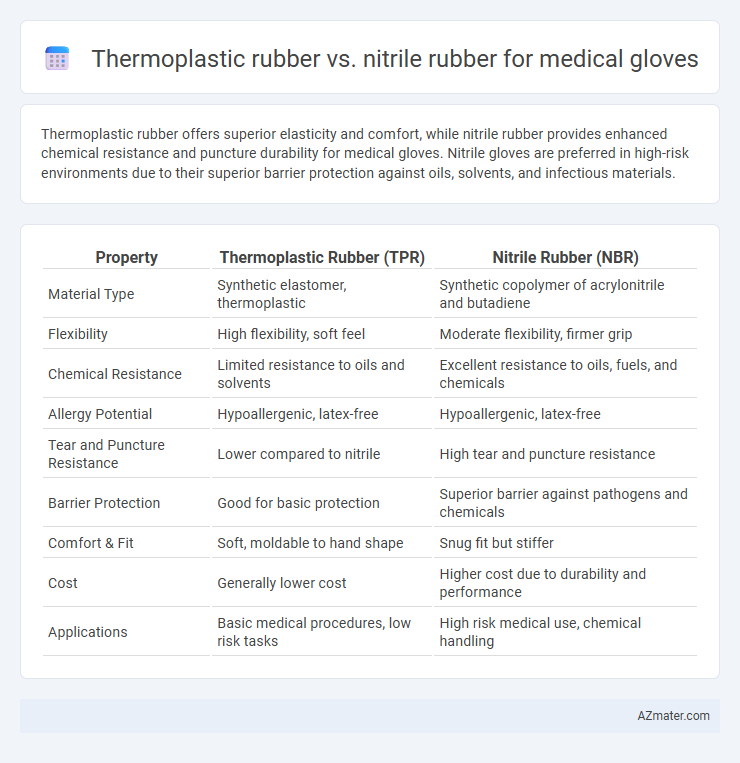Thermoplastic rubber offers superior elasticity and comfort, while nitrile rubber provides enhanced chemical resistance and puncture durability for medical gloves. Nitrile gloves are preferred in high-risk environments due to their superior barrier protection against oils, solvents, and infectious materials.
Table of Comparison
| Property | Thermoplastic Rubber (TPR) | Nitrile Rubber (NBR) |
|---|---|---|
| Material Type | Synthetic elastomer, thermoplastic | Synthetic copolymer of acrylonitrile and butadiene |
| Flexibility | High flexibility, soft feel | Moderate flexibility, firmer grip |
| Chemical Resistance | Limited resistance to oils and solvents | Excellent resistance to oils, fuels, and chemicals |
| Allergy Potential | Hypoallergenic, latex-free | Hypoallergenic, latex-free |
| Tear and Puncture Resistance | Lower compared to nitrile | High tear and puncture resistance |
| Barrier Protection | Good for basic protection | Superior barrier against pathogens and chemicals |
| Comfort & Fit | Soft, moldable to hand shape | Snug fit but stiffer |
| Cost | Generally lower cost | Higher cost due to durability and performance |
| Applications | Basic medical procedures, low risk tasks | High risk medical use, chemical handling |
Introduction to Medical Glove Materials
Thermoplastic rubber (TPR) and nitrile rubber are prominent materials used in medical glove manufacturing due to their unique properties. Nitrile rubber offers superior puncture resistance, chemical resistance, and hypoallergenic features, making it ideal for medical environments requiring enhanced protection. Thermoplastic rubber provides flexibility and comfort but lacks the chemical and abrasion resistance found in nitrile, limiting its use primarily to tasks with lower exposure risks.
Overview of Thermoplastic Rubber (TPR)
Thermoplastic Rubber (TPR) is a hybrid material combining the properties of rubber and thermoplastics, offering excellent flexibility, durability, and chemical resistance in medical gloves. Compared to Nitrile rubber, TPR provides superior elasticity and ease of processing, which enhances comfort and fit during extended use. Its hypoallergenic nature and recyclability make TPR an eco-friendly alternative for medical gloves requiring both performance and safety standards.
Overview of Nitrile Rubber
Nitrile rubber (NBR) is a synthetic elastomer widely used in medical gloves due to its superior chemical resistance, puncture resistance, and hypoallergenic properties compared to natural rubber. It offers excellent protection against oils, acids, and solvents, making it ideal for healthcare environments where exposure to hazardous substances is common. Its durability and barrier performance ensure reliable safety for medical professionals and patients alike.
Physical Properties: TPR vs Nitrile
Thermoplastic rubber (TPR) exhibits excellent flexibility and elasticity, offering superior elongation at break compared to nitrile rubber, which provides higher tensile strength and puncture resistance crucial for medical gloves. Nitrile rubber outperforms TPR in chemical resistance, especially against oils and solvents, making it more suitable for environments with harsh substances. Both materials provide good tactile sensitivity, but nitrile gloves deliver enhanced durability and protection in demanding medical applications.
Chemical Resistance Comparison
Thermoplastic rubber (TPR) offers moderate chemical resistance but generally underperforms compared to nitrile rubber in medical glove applications, especially against oils, fats, and various solvents. Nitrile rubber exhibits superior resistance to a broad spectrum of chemicals, including hydrocarbons, acids, and alkalis, making it the preferred choice for medical gloves requiring enhanced durability and protection. This superior chemical resistance in nitrile gloves reduces glove degradation and potential exposure risks when handling hazardous substances in clinical settings.
Comfort and Fit in Medical Applications
Thermoplastic rubber (TPR) offers superior elasticity and softer texture, enhancing comfort and providing a snug fit for extended medical glove use. Nitrile rubber is highly resistant to punctures and chemicals but may have less flexibility, potentially impacting overall comfort during prolonged wear. In medical applications, TPR gloves excel in comfort and fit, while nitrile gloves prioritize durability and protection without compromising essential tactile sensitivity.
Allergic Reactions: Latex-Free Alternatives
Thermoplastic rubber (TPR) and nitrile rubber are both popular latex-free alternatives used in medical gloves to minimize allergic reactions, with nitrile offering superior chemical resistance and puncture durability. TPR gloves provide flexibility and comfort but tend to have lower resilience against oils and chemicals compared to nitrile. Choosing nitrile rubber ensures enhanced protection for healthcare professionals and patients sensitive to latex proteins, reducing the risk of Type I hypersensitivity reactions.
Cost and Availability Analysis
Thermoplastic rubber medical gloves generally offer lower material and production costs compared to nitrile rubber gloves, making them a cost-effective option for large-scale usage. Nitrile rubber gloves, while more expensive, provide superior chemical resistance and durability, often affecting their availability during high-demand periods due to complex manufacturing processes. Availability of thermoplastic rubber gloves tends to be higher due to simpler production and widespread raw material supply, whereas nitrile gloves may face supply chain constraints driven by raw material fluctuations and increased healthcare demand.
Environmental Impact and Sustainability
Thermoplastic rubber (TPR) used in medical gloves offers enhanced recyclability and lower carbon footprint compared to nitrile rubber, which is synthetic and derived from petrochemicals with more intensive resource extraction. Nitrile gloves generate significant non-biodegradable waste and require complex recycling processes, contributing to long-term environmental pollution. Sustainable alternatives with TPR promote circular economy principles by enabling repeated processing and reducing dependency on fossil fuels in glove manufacturing.
Choosing the Best Material for Medical Gloves
Thermoplastic rubber (TPR) offers excellent flexibility and chemical resistance, making it a suitable option for medical gloves requiring durability and comfort. Nitrile rubber provides superior puncture resistance and allergen-free properties, ideal for medical environments demanding high protection and safety. Selecting the best material depends on specific needs like chemical exposure, tactile sensitivity, and allergy considerations within the medical setting.

Infographic: Thermoplastic rubber vs Nitrile rubber for Medical glove
 azmater.com
azmater.com